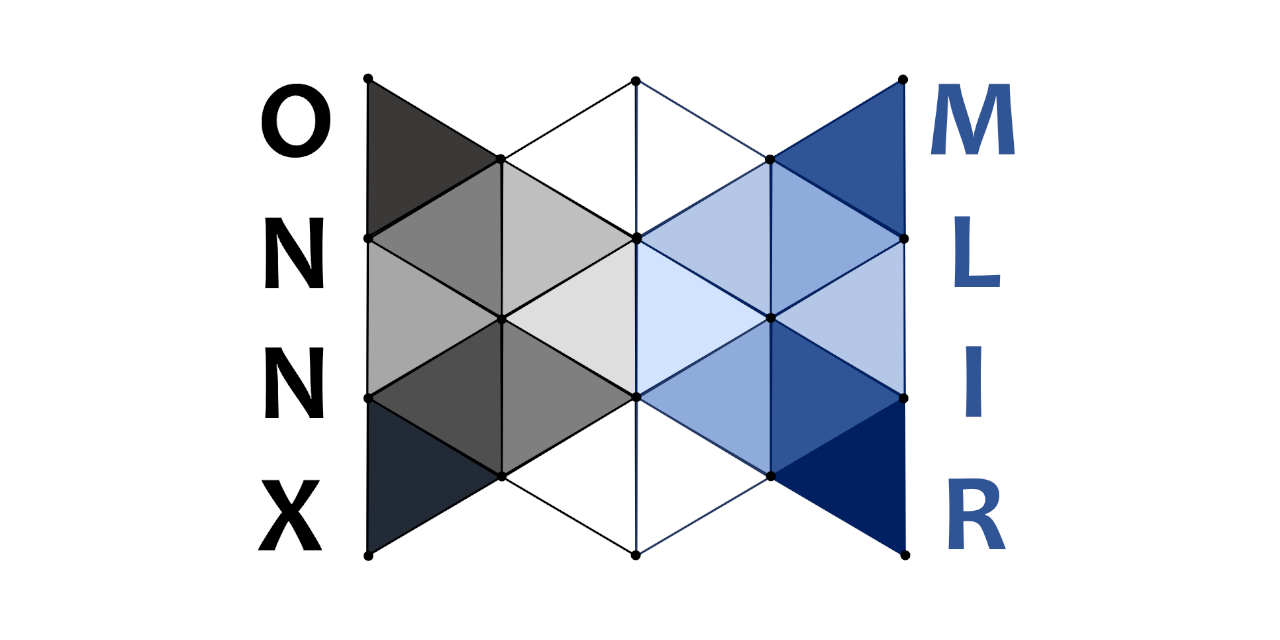This project (https://onnx.ai/onnx-mlir/) provides compiler technology to transform a valid Open Neural Network Exchange (ONNX) graph into code that implements the graph with minimum runtime support. It implements the ONNX standard and is based on the underlying LLVM/MLIR compiler technology.
| System | Build Status | Model Zoo Status |
|---|---|---|
| s390x-Linux | ||
| ppc64le-Linux | ||
| amd64-Linux | ||
| amd64-Windows | ||
| amd64-macOS | ||
This project contributes:
- an ONNX Dialect that can be integrated in other projects,
- a compiler interfaces that lower ONNX graphs into MLIR files/LLVM bytecodes/C & Java libraries,
- an
onnx-mlirdriver to perform these lowering, - and a python/C/C++/Java runtime environment.
Current level of support for ONNX operations are listed here for CPUs and IBM's Telum NNPA accelerator.
The preferred approach to using and developing ONNX-MLIR is to use Docker Images and Containers, as getting the proper code dependences may be tricky on some systems. Our instructions on using ONNX-MLIR with Dockers are here.
If you intend to develop code, you should look at our workflow document which help you setup your Docker environment in a way that let you contribute code easily.
ONNX-MLIR runs natively on Linux, OSX, and Windows. Detailed instructions are provided below.
python >= 3.8
gcc >= 6.4
protobuf >= 3.16.0
cmake >= 3.13.4
make >= 4.2.1 or ninja >= 1.10.2
java >= 1.11 (optional)
Help to update the prerequisites is found here.
At any point in time, ONNX-MLIR depends on a specific commit of the LLVM project that has been shown to work with the project. Periodically the maintainers need to move to a more recent LLVM level. Among other things, this requires to update the commit string in (utils/clone-mlir.sh). When updating ONNX-MLIR, it is good practice to check that the commit string of the MLIR/LLVM is the same as the one listed in that file.
Directions to install MLIR and ONNX-MLIR are dependent on your OS.
After installation, an onnx-mlir executable should appear in the build/Debug/bin or build/Release/bin directory.
If you have difficulties building, rebuilding, or testing onnx-mlir, check this page for helpful hints.
The usage of onnx-mlir is as such:
OVERVIEW: ONNX-MLIR modular optimizer driver
USAGE: onnx-mlir [options] <input file>
OPTIONS:
Generic Options:
--help - Display available options (--help-hidden for more)
--help-list - Display list of available options (--help-list-hidden for more)
--version - Display the version of this program
ONNX-MLIR Options:
These are frontend options.
Choose target to emit:
--EmitONNXBasic - Ingest ONNX and emit the basic ONNX operations without inferred shapes.
--EmitONNXIR - Ingest ONNX and emit corresponding ONNX dialect.
--EmitMLIR - Lower the input to MLIR built-in transformation dialect.
--EmitLLVMIR - Lower the input to LLVM IR (LLVM MLIR dialect).
--EmitObj - Compile the input to an object file.
--EmitLib - Compile and link the input into a shared library (default).
--EmitJNI - Compile the input to a jar file.
Optimization levels:
--O0 - Optimization level 0 (default).
--O1 - Optimization level 1.
--O2 - Optimization level 2.
--O3 - Optimization level 3.
The full list of options is given by the --help option. Note that just as most compilers, the default optimization level is -O0.
We recommend using -O3 for most applications.
Options are also read from the ONNX_MLIR_FLAGS environment variable. For example, ONNX_MLIR_FLAGS="-O3" will ensure -O3 for all compilations.
For example, use the following command to lower an ONNX model (e.g., add.onnx) to ONNX dialect:
./onnx-mlir --EmitONNXIR add.onnxThe output should look like:
module {
func.func @main_graph(%arg0: tensor<10x10x10xf32>, %arg1: tensor<10x10x10xf32>) -> tensor<10x10x10xf32> {
%0 = "onnx.Add"(%arg0, %arg1) : (tensor<10x10x10xf32>, tensor<10x10x10xf32>) -> tensor<10x10x10xf32>
return %0 : tensor<10x10x10xf32>
}
}An example based on the add operation is found here, which build an ONNX model using a python script, and then provide a main program to load the model's value, compute, and print the models output.
An end to end example is provided here, which train, compile, and execute a simple MNIST example using our C/C++, Python, or Java interface.
We have a slack channel established under the Linux Foundation AI and Data Workspace, named #onnx-mlir-discussion.
This channel can be used for asking quick questions related to this project.
A direct link is here.
You may also open GitHub Issues for any questions and/or suggestions you may have.
Do not use public channels to discuss any security-related issues; use instead the specific instructions provided in the SECURITY page.
Documentation is provided in the docs sub-directory; the DocumentList page provides an organized list of documents. Information is also provided on our public facing
onnx.ai/onnx-mlir pages.
We are welcoming contributions from the community. Please consult the CONTRIBUTING page for help on how to proceed.
ONNX-MLIR requires committers to sign their code using the Developer Certificate of Origin (DCO).
Practically, each git commit needs to be signed, see here for specific instructions.
The ONNX-MLIR code of conduct is described at https://onnx.ai/codeofconduct.html.
